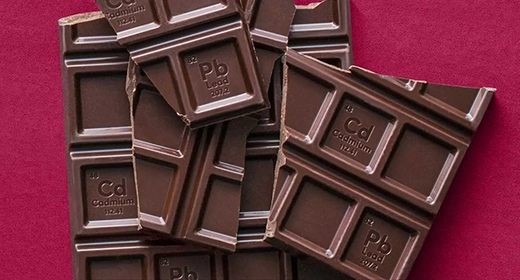by Kevin Loria: Consumer Reports found dangerous heavy metals in chocolate from Hershey’s, Theo, Trader Joe’s and other popular brands.
Here are the ones that had the most, and some that are safer.
For many of us, chocolate is more than just a tasty treat. It’s a mood lifter, an energy booster, a reward after a tough day, a favorite holiday gift.
People also choose dark chocolate in particular for its potential health benefits, thanks to studies that suggest its rich supply of antioxidants may improve heart health and other conditions, and for its relatively low levels of sugar. In fact, more than half of people in a recent survey from the National Confectioners Association described dark chocolate as a “better for you” candy.
But there’s a dark side to this “healthier” chocolate. Research has found that some dark chocolate bars contain cadmium and lead—two heavy metals linked to a host of health problems in children and adults.
The chocolate industry has been grappling with ways to lower those levels. To see how much of a risk these favorite treats pose, Consumer Reports scientists recently measured the amount of heavy metals in 28 dark chocolate bars. They detected cadmium and lead in all of them.
Heavy Metals in Dark Chocolate
CR tested a mix of brands, including smaller ones, such as Alter Eco and Mast, and more familiar ones, like Dove and Ghirardelli.
For 23 of the bars, eating just an ounce a day would put an adult over a level that public health authorities and CR’s experts say may be harmful for at least one of those heavy metals. Five of the bars were above those levels for both cadmium and lead. Read more about how CR tested dark chocolate (PDF).
That’s risky stuff: Consistent, long-term exposure to even small amounts of heavy metals can lead to a variety of health problems. The danger is greatest for pregnant people and young children because the metals can cause developmental problems, affect brain development, and lead to lower IQ, says Tunde Akinleye, the CR food safety researcher who led this testing project.
“But there are risks for people of any age,” he says. Frequent exposure to lead in adults, for example, can lead to nervous system problems, hypertension, immune system suppression, kidney damage, and reproductive issues. While most people don’t eat chocolate every day, 15 percent do, according to the market research firm Mintel. Even if you aren’t a frequent consumer of chocolate, lead and cadmium can still be a concern. It can be found in many other foods—such as sweet potatoes, spinach, and carrots—and small amounts from multiple sources can add up to dangerous levels. That’s why it’s important to limit exposure when you can.
Still, you don’t need to swear off chocolate entirely, Akinleye says. He adds that while most of the chocolate bars in CR’s tests had concerning levels of lead, cadmium, or both, five of them were relatively low in both. “That shows it’s possible for companies to make products with lower amounts of heavy metals—and for consumers to find safer products that they enjoy,” he says.
And in addition to choosing your dark chocolates wisely, there are a number of other steps you can take to continue enjoying chocolate safely.
Chocolate is made from the cacao bean, which has two main components: cocoa solids and cocoa butter. Together, these are called cacao or cocoa.
Dark chocolate’s reputation as a relatively healthy treat stems mostly from the cocoa solids. These are packed with flavanols, which are antioxidants linked to improved blood vessel function, reduced inflammation, and lower cholesterol. Dark chocolate is also lower in sugar and higher in fiber than milk chocolate, and it has magnesium and potassium. Unfortunately, cocoa solids are also where the heavy metals, especially cadmium, lurk. That makes it tricky to balance dark chocolate’s risks and benefits.
Some of the same concerns may extend to products made with cocoa powder—which is essentially pure cocoa solids—such as hot cocoa, and brownie and cake mixes, though they have varying amounts of cacao and possibly heavy metals.
Dark chocolate tends to be higher in heavy metals than milk chocolate, probably because of its higher cacao content. There is no official cutoff, but dark chocolates are generally at least 65 percent cacao by weight, says Michael J. DiBartolomeis, PhD, a toxicologist and former official at the California Department of Public Health who has researched heavy metals in chocolate.
Getting the Lead and Cadmium Out
To further complicate the issue, lead and cadmium appear to get into cacao in different ways, which means that each requires a different type of fix, DiBartolomeis says.
Between 2019 and 2022, he and other researchers studied how metals might contaminate cacao, as part of a settlement to a lawsuit against chocolate manufacturers brought by As You Sow, an organization that pushes for corporate accountability. As You Sow had previously found high levels of lead and cadmium in some chocolates.
The researchers found that cacao plants take up cadmium from the soil, with the metal accumulating in cacao beans as the tree grows. That’s similar to how heavy metals contaminate some other foods.
But lead seems to get into cacao after beans are harvested. The researchers found that the metal was typically on the outer shell of the cocoa bean, not in the bean itself. Moreover, lead levels were low soon after beans were picked and removed from pods but increased as beans dried in the sun for days. During that time, lead-filled dust and dirt accumulated on the beans. “We collected beans on the ground that were heavily loaded with lead on the outer shell,” DiBartolomeis says.
Because of the different ways that cadmium and lead get into chocolate, addressing the contamination requires different solutions.
For lead, that will mean changes in harvesting and manufacturing practices, says Danielle Fugere, president of As You Sow. Such practices could include minimizing soil contact with beans as they lie in the sun, and drying beans on tables or clean tarps away from roads or with protective covers, so lead-contaminated dust won’t land on them. Another option is finding ways to remove metal contaminants when beans are cleaned at factories, Fugere says.
Solving for cadmium is trickier, though it is possible, DiBartolomeis says. Carefully breeding or genetically engineering plants to take up less of the heavy metal could help, though that could take several years. Other potential options include replacing older cacao trees with younger ones, because cadmium levels tend to increase as the plants get older, and removing or treating soil known to be contaminated with cadmium.
Safer Chocolate
More immediately, DiBartolomeis says, chocolate makers should survey cacao-growing areas to determine cadmium levels, and favor beans from places with lower levels. If necessary, they should blend beans from higher-cadmium areas with beans with lower levels, as some manufacturers do now. Alex Whitmore, CEO at Taza, which makes one of the products with lower levels of both metals in CR’s tests, says that’s what his company does, mixing beans from “different origins to ensure that the final product” has lower levels.
The National Confectioners Association, which funded the research into heavy metals in chocolate as part of the As You Sow settlement, says “lead reductions can be expected within the first year of implementing new handling practices,” though it says lowering cadmium may take longer.
Some manufacturers with higher levels of metals in our tests said their products are below levels set by the settlement. Others said that the metals occur naturally in soil and that they take steps to try to reduce it. Alter Eco, Endangered Species, Theo, and Trader Joe’s did not respond.
Taking steps to reduce heavy metals in cacao can pay off: CR’s test results, after all, show that while contamination with heavy metals is common, it is not inevitable.
And in addition to choosing products with lower levels of lead and cadmium, other steps can also help reduce the risks. In fact, DiBartolomeis says that while he cautions pregnant people and children from eating dark chocolate, he doesn’t tell most people to give it up, just to know the risks and not overdo it.
Better Ways to Eat Dark Chocolate
Calculating the exact amount of dark chocolate that’s risky to eat is complicated. That’s because heavy metal levels can vary, people have different risk levels, and chocolate is just one potential source of heavy metal exposure. But experts say that by being mindful of the risks, you can still enjoy dark chocolate while minimizing the potential harms.
Choose dark chocolates with the lowest levels of heavy metals. CR’s tests found five chocolates—one each from Mast, Taza, and Valrhona, and two from Ghirardelli—with relatively low levels of both lead and cadmium. Eight more are lower in only lead, and 10 others in just cadmium. Only five bars—one each from Green & Black’s, Lily’s (owned by the Hershey company), and Trader Joe’s, and two from Theo—were higher for both heavy metals.
Treat chocolate as a treat. A single ounce of even one of the chocolates with the highest cadmium and lead levels in CR’s tests is unlikely to cause any immediate harm. The risk comes with frequent consumption over time. Heavy metals are also in certain other foods, including many that are more nutritious and important to eat as a regular parts of a healthy diet, such as carrots, sweet potatoes, and spinach. So it’s best to eat dark chocolate only occasionally. “Having a serving a few days a week, especially with a product that has lower levels, means you can eat dark chocolate without worrying unduly,” says CR’s Tunde Akinleye, who oversaw the chocolate tests.
Try dark chocolates with lower cacao percentages. If you’re considering a bar that CR didn’t test, so the heavy metal content is unknown, you may want to opt for a 70 percent dark chocolate product over an 80 percent one, for example, or a 65 percent bar over a 70 percent one. That’s not a foolproof measure, but CR’s tests, as well as testing done by other organizations, suggest that cadmium levels tend to increase with the percentage of cacao. (Lead levels don’t seem to be as closely tied to cacao percentage.)
Alternate with milk chocolate. Cacao levels are lower in milk chocolate than in dark chocolate, so milk chocolate tends to have lower levels of heavy metals, DiBartolomeis says. But that doesn’t mean you can eat it with abandon: It has a lot more added sugars. So it is best to eat both kinds of chocolates only occasionally, not every day.
Don’t assume organic dark chocolates are safer. In CR’s tests, they were just as likely as other products to have concerning levels of heavy metals.
Don’t give kids much dark chocolate. Dark chocolate isn’t a big hit with most kids, which is just as well, considering the younger you are, the bigger the threat from heavy metals. Pregnant people should limit consumption as well.
Think about your total chocolate consumption. We did not test for heavy metals in cocoa powder, hot cocoa mixes, or other chocolate desserts. But they contain cocoa solids, too, so they could contribute to your heavy metal intake.
Eat a well-rounded diet. Switching up the foods you eat may help you avoid overconsumption of heavy metals from other sources. Grapes, apples, green tea, and certain other healthy foods can even provide some of the same flavanols that chocolate supplies. Plus, doing this can help provide a variety of nutrients that may help offset some of the harm that heavy metals do. These include calcium, iron, selenium, vitamin C, and zinc.

Kevin Loria
I’m a science journalist who writes about health for Consumer Reports. I’m interested in finding the ways that people can transform their health for the better and in calling out the systems, companies, and policies that expose patients to unnecessary harm. As a dad, I spend most of my free time trying to keep up with a toddler, but I also enjoy exploring the outdoors whenever possible. Follow me on Twitter(@kevloria).











































